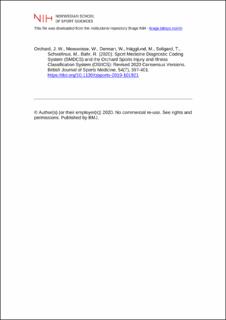| dc.contributor.author | Orchard, John W. | |
| dc.contributor.author | Meeuwisse, Willem | |
| dc.contributor.author | Derman, Wayne | |
| dc.contributor.author | Hägglund, Martin | |
| dc.contributor.author | Soligard, Torbjørn | |
| dc.contributor.author | Schwellnus, Martin | |
| dc.contributor.author | Bahr, Roald | |
| dc.date.accessioned | 2020-07-10T06:48:15Z | |
| dc.date.available | 2020-07-10T06:48:15Z | |
| dc.date.created | 2020-06-08T09:22:07Z | |
| dc.date.issued | 2020 | |
| dc.identifier.citation | British Journal of Sports Medicine. 2020, 54(7), 397-401. | en_US |
| dc.identifier.issn | 0306-3674 | |
| dc.identifier.uri | https://hdl.handle.net/11250/2663641 | |
| dc.description | No commercial re-use. See rights and permissions. Published by BMJ. | en_US |
| dc.description.abstract | Coding in sports medicine generally uses sports-specific coding systems rather than the International Classification of Diseases (ICD), because of superior applicability to the profile of injury and illness presentations in sport. New categories for coding were agreed on in the 'International Olympic Committee (IOC) consensus statement: Methods for recording and reporting of epidemiological data on injury and illness in sports 2020.' We explain the process for determining the new categories and update both the Sport Medicine Diagnostic Coding System (SMDCS) and the Orchard Sports Injury and Illness Classification System (OSIICS) with new versions that operationalise the new consensus categories. The author group included members from an expert group attending the IOC consensus conference. The primary authors of the SMDCS (WM) and OSIICS (JO) produced new versions that were then agreed on by the remaining authors using expert consensus methodology. The SMDCS and OSIICS systems have been adjusted and confirmed through a consensus process to align with the IOC consensus statement to facilitate translation between the two systems. Problematic areas for defining body part categories included the groin and ankle regions. For illness codes, in contrast to the ICD, we elected to have a taxonomy of 'organ system/region' (eg, cardiovascular and respiratory), followed by an 'aetiology/pathology' (eg, environmental, infectious disease and allergy). Companion data files have been produced that provide translations between the coding systems. The similar structure of coding underpinning the OSIICS and SMDCS systems aligns the new versions of these systems with the IOC consensus statement and also facilitates easier translation between the two systems. These coding systems are freely available to the sport and exercise research community. | en_US |
| dc.language.iso | eng | en_US |
| dc.subject | diagnosis | en_US |
| dc.subject | epidemiology | en_US |
| dc.subject | illness | en_US |
| dc.subject | injury | en_US |
| dc.title | Sport Medicine Diagnostic Coding System (SMDCS) and the Orchard Sports Injury and Illness Classification System (OSIICS): Revised 2020 Consensus Versions | en_US |
| dc.type | Peer reviewed | en_US |
| dc.type | Journal article | en_US |
| dc.description.version | publishedVersion | en_US |
| dc.rights.holder | © Author(s) (or their employer(s)) 2020. | en_US |
| dc.source.pagenumber | 397-401 | en_US |
| dc.source.volume | 54 | en_US |
| dc.source.journal | British Journal of Sports Medicine | en_US |
| dc.source.issue | 7 | en_US |
| dc.identifier.doi | 10.1136/bjsports-2019-101921 | |
| dc.identifier.cristin | 1814262 | |
| dc.description.localcode | Institutt for idrettsmedisinske fag / Department of Sports Medicine | en_US |
| cristin.ispublished | true | |
| cristin.fulltext | original | |
| cristin.qualitycode | 2 | |
